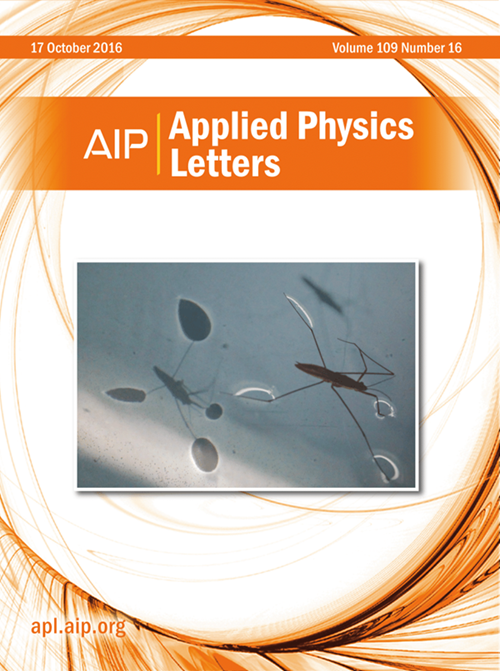通过高效钙钛矿/有机串联太阳能电池的多功能添加剂定制载流子管理
IF 3.5
2区 物理与天体物理
Q2 PHYSICS, APPLIED
引用次数: 0
摘要
宽禁带钙钛矿太阳能电池(PSCs)是高效串联光伏电池的理想选择。然而,这些器件遇到了钙钛矿晶格和界面缺陷带来的挑战,这些缺陷会导致非辐射复合和电压损失。为了解决这些问题,我们开发了一种协同方法,将l-胱氨酸二盐酸盐作为添加剂的批量钝化与随后的表面钝化处理相结合。该化合物通过羰基和胺官能团有效钝化Pb2+和卤化物缺陷。实验和模拟结果表明,l-胱氨酸二盐酸盐能有效地降低陷阱态,延缓成核动力学,促进晶粒生长,提高结晶度。结果表明,加入l-胱氨酸二盐酸盐的器件[FA0.8Cs0.2Pb(I0.6Br0.4)3,能隙:1.77 eV]的功率转换效率(PCE)约为16.00%,在添加碘化辛胺表面钝化后,PCE进一步提高到17.03%。扩展我们的方法,我们制造了宽带隙半透明器件,PCE为15.62%。当与窄带隙有机太阳能电池集成在四端(4T)钙钛矿/有机串联太阳能电池中时,效率达到了23.14%。该策略有效地提高了宽禁带PSCs的性能,在推进钙钛矿/有机光伏技术方面显示出巨大的潜力。本文章由计算机程序翻译,如有差异,请以英文原文为准。
Tailoring carrier management through a multifunctional additive for efficient perovskite/organic tandem solar cells
The wide bandgap perovskite solar cells (PSCs) are promising candidates for high-efficiency tandem photovoltaics. However, these devices encounter challenges arising from defects within the perovskite lattice and at interfaces, which lead to non-radiative recombination and voltage losses. To address these issues, we have developed a synergistic approach that combines bulk passivation using l-cystine dihydrochloride as an additive with subsequent surface passivation treatments. This compound effectively passivates Pb2+ and halide defects through its carbonyl and amine functional groups. Both experimental and simulation results demonstrate that l-cystine dihydrochloride effectively reduces trap states, retards nucleation kinetics, promotes grain growth, and enhances crystallinity. Consequently, the device [FA0.8Cs0.2Pb(I0.6Br0.4)3, energy gap: 1.77 eV] incorporating l-cystine dihydrochloride achieved a power conversion efficiency (PCE) of approximately 16.00%, which was further increased to 17.03% with an additional octylammonium iodide surface passivation. Expanding our approach, we have fabricated the wide bandgap semitransparent device, yielding a PCE of 15.62%. When integrated with narrow-bandgap organic solar cells in four-terminal (4T) perovskite/organic tandem solar cells, a remarkable efficiency of 23.14% was attained. This strategy effectively improves the performance of wide bandgap PSCs, which exhibit great potential in advancing perovskite/organic photovoltaic technologies.
求助全文
通过发布文献求助,成功后即可免费获取论文全文。
去求助
来源期刊

Applied Physics Letters
物理-物理:应用
CiteScore
6.40
自引率
10.00%
发文量
1821
审稿时长
1.6 months
期刊介绍:
Applied Physics Letters (APL) features concise, up-to-date reports on significant new findings in applied physics. Emphasizing rapid dissemination of key data and new physical insights, APL offers prompt publication of new experimental and theoretical papers reporting applications of physics phenomena to all branches of science, engineering, and modern technology.
In addition to regular articles, the journal also publishes invited Fast Track, Perspectives, and in-depth Editorials which report on cutting-edge areas in applied physics.
APL Perspectives are forward-looking invited letters which highlight recent developments or discoveries. Emphasis is placed on very recent developments, potentially disruptive technologies, open questions and possible solutions. They also include a mini-roadmap detailing where the community should direct efforts in order for the phenomena to be viable for application and the challenges associated with meeting that performance threshold. Perspectives are characterized by personal viewpoints and opinions of recognized experts in the field.
Fast Track articles are invited original research articles that report results that are particularly novel and important or provide a significant advancement in an emerging field. Because of the urgency and scientific importance of the work, the peer review process is accelerated. If, during the review process, it becomes apparent that the paper does not meet the Fast Track criterion, it is returned to a normal track.
 求助内容:
求助内容: 应助结果提醒方式:
应助结果提醒方式:


